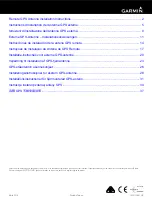
4
- - - - - - - - - - - - - - - - - - - - - - - - - - - - - - - - - - - - - - - - - - - - - - - - - - - - - - - - - - - - - - - - - - - - - - - - - - - - - - - - - - - - - - - - - - - - - - - - - - - - - -
L A B E L I T A L Y S R L
- V i a S . A l l e n d e , 5 9 – 4 1 1 2 2 M O D E N A
T E L : 0 5 9 / 3 6 2 9 9 3 F A X : 0 5 9 / 3 7 6 0 5 6
P . I V A 0 2 5 7 8 7 5 0 3 6 2 C a p i t a l e S o c i a l e 3 2 . 5 0 0 E u r o
w e b - w w w . l a b e l i t a l y . c o m e - m a i l - i n f o @ l a b e l i t a l y . c o m
An electromagnetic wave
It is important to match the polarization of the RF antenna to that of the incoming signal. In this way
the maximum signal is obtained. If the RF antenna polarization does not match that of the signal
there is a corresponding decrease in the level of the signal. It is reduced by a factor of cosine of
the angle between the polarisation of the RF antenna and the signal. Accordingly the polarisation
of the antennas located in free space is very important, and obviously they should be in exactly the
same plane to provide the optimum signal. If they were at right angles to one another (i.e. cross-
polarised) then in theory no signal would be received. For terrestrial radio communications
applications it is found that once a signal has been transmitted then its polarisation will remain
broadly the same. However reflections from objects in the path can change the polarisation. As
the received signal is the sum of the direct signal plus a number of reflected signals the overall
polarisation of the signal can change slightly although it remains broadly the same.
POLARISATION CATEGORIES
Vertical and horizontal are the simplest forms of antenna polarization and they both fall into a
category known as linear polarisation. However it is also possible to use circular polarisation.
Circular polarisation can be seen to be either right or left handed dependent upon the direction of
rotation as seen from the transmitter. Another form of polarisation is known as elliptical
polarisation. It occurs when there is a mix of linear and circular polarisation. However it is possible
for linearly polarised antennas to receive circularly polarised signals and vice versa. The strength
will be equal whether the linearly polarised antenna is mounted vertically, horizontally or in any
other plane but directed towards the arriving signal.
There will be some degradation because the signal level will be 3 dB less than if a circularly
polarised antenna of the same sense was used. The same situation exists when a circularly
polarised antenna receives a linearly polarised signal.
APPLICATIONS OF ANTENNA POLARISATION
Different types of polarisation are used in different applications to enable their advantages to be
used. Linear polarization is by far the most widely used for most radio communications
applications. Vertical polarisation is often used for mobile radio communications. This is because
many vertically polarized antenna designs have an omni-directional radiation pattern and it means
that the antennas do not have to be re-orientated as positions as always happens for mobile radio
communications as the vehicle moves. For other radio communications applications the
polarisation is often determined by the RF antenna considerations. Some large multi-element
antenna arrays can be mounted in a horizontal plane more easily than in the vertical plane. This is
because the RF antenna elements are at right angles to the vertical tower of pole on which they
are mounted and therefore by using an antenna with horizontal elements there is less physical and
electrical interference between the two. This determines the standard polarisation in many cases.




























